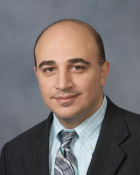Treatment for aortic stenosis varies depending on whether you have symptoms and how severe the disease is. If your condition is mild or moderate and you do not have any symptoms, your doctor will likely monitor you and check your heart function regularly.
In addition, your doctor will likely recommend following a heart-healthy lifestyle. This includes:
- Eating a healthy diet
- Not smoking
- Getting regular exercise
- Maintaining a healthy weight or losing weight if you need to
- Managing any other health problems you might have, such as diabetes
However, if your aortic stenosis is severe, your doctor might suggest a procedure to replace the valve. Several minimally invasive procedures, performed by providers in the UK Gill Heart & Vascular Institute’s structural heart disease program, are available for patients who qualify. These types of procedures only require very small openings in the chest.
Transcatheter aortic valve replacement (TAVR) is an advanced minimally invasive procedure that allows the heart care team to insert a new valve without removing the damaged one. Instead, the team uses a catheter to fit a new valve inside the old valve. When the new valve expands, it takes over the job of the old valve and the diseased valve is no longer functional. UK HealthCare is one of only a few hospitals in Kentucky that offers TAVR.
For patients who are not candidates for TAVR, our skilled surgeons perform open-heart valve replacements. During valve replacement surgery, performed under general anesthesia, a surgeon will open your chest to access your heart. The aortic valve is removed, and a new heart valve is placed. The valve can be mechanical — meaning it’s made of titanium or carbon — or it can be a biological valve made of animal or human tissue. After the valve is in place and working, the surgeon closes your chest.
When other options are not suited for a patient, we may recommend a balloon valvuloplasty. This procedure uses cardiac catheterization to repair the damaged valve. The interventional cardiologist uses a small catheter to place an expandable balloon into the narrowed valve. The balloon is then expanded to stretch the valve open.









